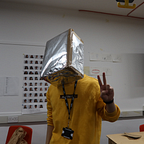22/04/21–10/06/21 (7 weeks)
📃Brief: Design a way to materialise the blockchain.
🤝Group Members: Alex Newson, Tatiana Bohsali, Sue Heeyeon An, Yiwei Han (David).
👁🗨External Partner: This Ain’t Rock’n’Roll — Charlie Waterhouse, Clive Russell
Extraction from precedents
Following the professor’s advice, we decided to re-analyse the precedents carefully in order to understand how the process of ‘self-ownership’ and ‘reproduction’ works.
Through this analysis, we learnt what techniques and interactive forms were needed to achieve blockchain-based lifeform. At the same time, there were three key points to learn from: the OpenCV used by Terra0 enables the forest to assess the goodness of different trees through image analysis; and Plantoid’s offspring are required to inherit part of the DNA of the first generation (including the aesthetic and physical requirements; the business model; the governance rules) via Smart Contracts, which ensures that the offspring are consistent with the core functions and ideas of the first generation; People voted for the best proposal by sending micro-transactions in blockchain (the weight of the vote depends on the size of the donation).
How do people use the shop?
We started thinking and talking carefully about how a self-owned shop would interact with people and how it would expand. We decided that people needed an account and a QR code to access and use the shop. We wanted the items that people shared in the shop to be useful and valuable, so we came up with a PoU (Proof of Use) mechanism to achieve this.
PoU: The shop has a timer function where each item is only stored in the shop for a certain amount of time and if someone uses it before the time is up, the timer is suspended, otherwise the item is moved to the ‘unwanted section’. If the item is used frequently by more than one person during the time, the timer will extend the storage time for it.
How is the macro shop network built?
The way to make money in the shop: Pay as you feel.
Proposal mechanism: each donor is able to propose the look, function, budget and location of the next shop through the app. And everyone has the same weight of votes. The proposal with the most votes will be automatically executed by the smart contract when the target budget is reached.
Shop Chain Network System: As one shop after another is created, a network will be created through smart contracts. Each shop will transmit data to each other and mutually support and complement each other through analytics.
Prototyping
Middle Point Presentation
We presented the idea smoothly. The partners liked the idea that the shop had its own ideas and felt it fitted in well with the community culture of Brixton. But they weren’t sure about the part where the camera verifies the item, due to the personal privacy issues touched upon. And it raised questions worth thinking about: how do we prevent people from misusing it (e.g. putting drugs or marijuana in the store. John suggested that we need to make a lot of the information hidden in the diagram more apparent and asked a good question worth thinking about: what makes it not a vending machine?
In the next week we need to fine tune the details and think about how to implement this idea in as higher resolution as you can in the next few weeks.
Reflection
Sometimes designers are not problem solvers, but rather cunning ‘escapees’. We have chosen to put wheels on shops so that they can move in order to avoid the tricky problem of ‘paying for land’. The result is that mobility does add democracy to the shop.
In terms of the word “materialized”, I personally understand it in two ways: 1. “make it applied/realized”. In this perspective our group did not bad, as we learned and adopted the main technologies and mechanisms of the blockchain, but some are on a more conceptual level.
2. “make it material”. In this perspective I think we have not done enough, maybe we should materialise more of what happens on the blockchain rather than just the shop form and interface interaction.
📚References
Catlow, R., Garrett, M., Jones, N. and Skinner, S., 2017. Artists Re: thinking the Blockchain (Vol. 1, №3rd). Torque editions.
Plantoid.org. (n.d.). Plantoids: Blockchain-based life forms. [online] Available at: http://plantoid.org/#love [Accessed 6 Jun. 2021].
Seidler, P., Kolling, P. and Hampshire, M. (2016). terra0 Can an augmented forest own and utilise itself? [online] . Available at: https://terra0.org/assets/pdf/terra0_white_paper_2016.pdf [Accessed 6 Jun. 2021].
